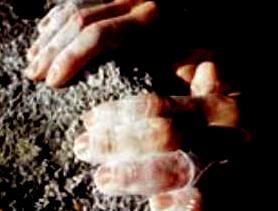The chalk commonly used by rock-climbers to improve their grip is a whitish powder, referred to as gymnasts’ chalk or magnesite. Here we outline some scientific information taken from specialised journals on the potential toxic effects of climbing chalk.
The Introduction to TLVs in the national labour contract for chemical industry workers includes the following statement: “Magnesium carbonate, also known as magnesite or gymnasts’ chalk, is not toxic in so far as it is not classed as toxic or harmful according to the conventional classification.
Magnesite is classed as a toxicologically inert substance. However, the ACGIH (the American Conference of Governmental Industrial Hygienists) has assigned the substance, when in the form of a fine powder, a TLV value (i.e. the maximum concentration permitted in a working environment for 8 consecutive hours) of 10 mg/mc, with the note (e). The TLV value is a threshold weighted for 8 hours’ work which, if not exceeded, indicates that any pathogenic potential is absent. There is a problem, which is the same for all fine powders, in so far as they are deposited in the alveoli of the lungs. There is no need for excessive alarm. The note (e) indicates that this threshold value is applicable only where there is crystalline silica (which cannot be completely ruled out in gymnasts’ chalk) conventionally less than 1%.
Like other powders, magnesite is classed as an “inert†powder, although this definition is not really apt, as there are no powders which do not cause a reaction, however slight, in the cells of the lungs if inhaled in sufficient quantities.
However, the reaction of the lung tissue to inhalation has the following characteristics:
1. The structure of the alveoli remains intact.
2. Collagen (scar tissue) is not formed in significant quantities.
3. The reaction of the tissues is potentially reversible.
An excessive concentration of particles in the air in the work-place may reduce proper visibility, cause irritating deposits of particles in the eyes, ears and upper respiratory apparatus, harm the skin or mucous membranes through chemical or mechanical action, or as a result of repeated washing to remove the powder.



